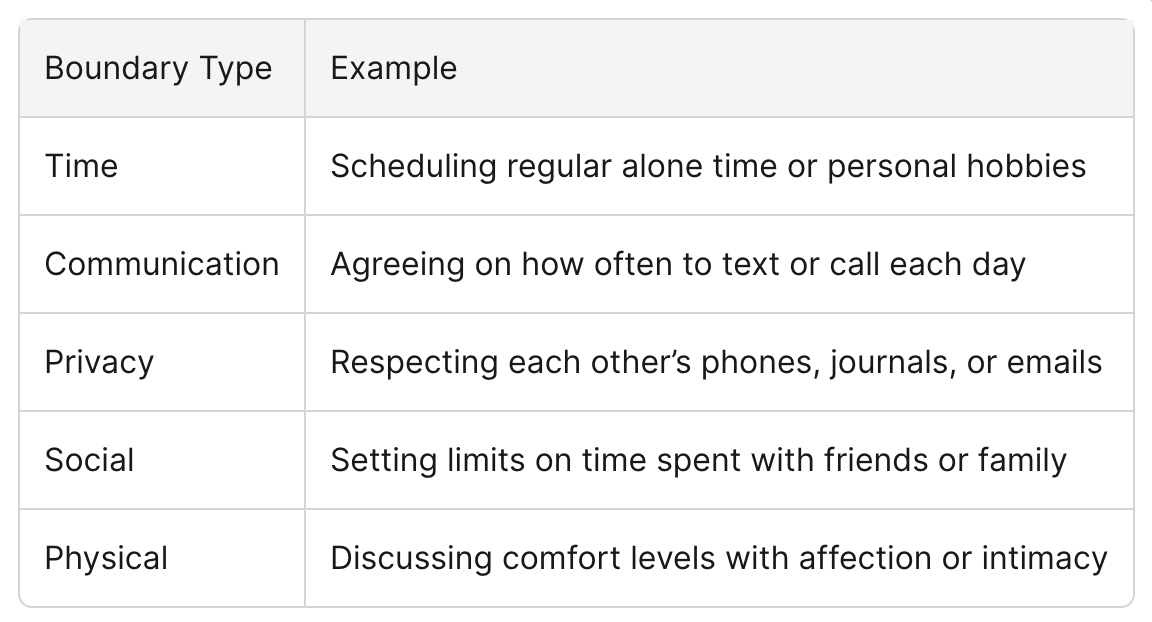A survey of 10,000 Indian adults (aged 18–35) by the dating app QuackQuack found 32% believe that “setting boundaries as soon as you match is essential to avoid unhealthy boundaries and helping protect emotional well‑being in new relationships."
If you’ve ever felt overwhelmed, misunderstood, or just plain exhausted by your relationships, you’re not alone. Let’s explore why healthy boundaries aren’t just a buzzword—they’re a relationship lifesaver.
What are Healthy Boundaries?
Healthy boundaries are the invisible lines that define where you end and others begin. They’re the rules you set for how you want to be treated, what you’re comfortable with, and what’s off-limits. Think of them as the velvet ropes at a VIP event—except, in this case, you are the VIP.
Why are Healthy Boundaries Essential?
- Protect your emotional and mental space
- Reduce stress and prevent burnout
- Foster trust and respect
- Boost self-esteem and self-worth
Types of Healthy Boundaries
Healthy boundaries are the guidelines we set to protect our well-being and maintain respectful, balanced relationships. They’re not about keeping people out—they’re about letting the right people in, on terms that honour both parties. Here are the main types of healthy boundaries, or key boundaries, you should know:
Emotional Boundaries
These define how much emotional energy you give and receive in relationships. Emotional boundaries help you separate your feelings from others’ behaviour, prevent codependency, and ensure you don’t sacrifice your well-being to support someone else.
Example: “I care about your struggles, but I can’t be your only source of support. Let’s talk about other ways you can get help.”
Physical Boundaries
Physical boundaries relate to personal space, physical touch, and privacy. They include your comfort level with affection, proximity, and who can access your personal belongings.
Example: “I need some quiet time after work before we catch up.”
Sexual Boundaries
These involve your comfort level with physical intimacy, sexual activity, consent, and preferences. Openly discussing what feels safe and enjoyable ensures both partners feel respected.
Example: “I’m not comfortable with that, but I’d love to talk about what works for both of us.”
Intellectual Boundaries
Intellectual boundaries protect your thoughts, ideas, and opinions. They ensure that disagreements remain respectful and don’t become personal attacks.
Example: “I respect your opinion, but I’d appreciate it if we could discuss this topic without insults or any inappropriate behaviour.”
Time Boundaries
Time boundaries help you prioritise your own needs, manage commitments, and avoid overextending yourself. They involve setting limits on the amount of time you spend on certain activities or with specific people.
Example: “I’m happy to help, but I need to finish my work first. Can we talk later?”
Material/Financial Boundaries
These boundaries relate to your possessions and finances, including who can borrow your things, how you share expenses, and what you’re comfortable giving.
Example: “You’re welcome to use my car, but please ask first.”
Healthy boundaries are “just right”—firm enough to protect you, flexible enough to allow connection. Setting and communicating them is essential for maintaining your self-respect, reducing resentment, and building fulfilling relationships.
Why Boundaries Matter in Love
Setting healthy boundaries in love isn’t about building walls—it’s about creating a safe, nurturing space where both romantic partners can thrive. Here’s why boundaries are essential for lasting, fulfilling relationships:
1. Build Trust and Respect
Boundaries clarify what each partner values and needs. By openly communicating your limits, you invite your partner to respect them, which strengthens mutual understanding, trust and respect. When both people feel heard and honoured, the relationship becomes a safe haven rather than a battlefield.
%20(1).jpg)
2. Preserve Individuality
Love doesn’t mean losing yourself. Healthy boundaries ensure that each person maintains their sense of self, personal interests, and friendships outside the relationship. This individuality fuels attraction and keeps the relationship vibrant and balanced.
3. Prevent Resentment and Burnout
Without boundaries, it’s easy to overextend yourself or neglect your own needs. This can lead to resentment, frustration, and emotional exhaustion. Boundaries help you say “no” when necessary, protecting your well-being and preventing burnout, which can lead to mental health issues.
4. Encourage Open Communication
Boundaries require honest conversations about needs, desires, and discomforts. This openness lays the groundwork for effective communication, reducing misunderstandings and helping both partners feel valued and understood.
5. Foster Emotional Safety
When you know your limits will be respected, you feel safer to be vulnerable and authentic. Emotional safety is the bedrock of intimacy and connection in love.
6. Support Growth—Together and Apart
Healthy boundaries allow both partners to pursue personal growth while supporting each other. This balance encourages both individual and shared development, making the relationship more resilient over time.
In short: Boundaries in love are not about keeping your partner out—they’re about letting them in on your terms, with respect and care for both people’s needs. They’re the invisible scaffolding that supports a strong, loving partnership.
How to Set Healthy Boundaries in a Relationship
Setting healthy boundaries in a relationship is a vital skill for building trust, respect, and lasting intimacy. Here’s a step-by-step guide to help you establish boundaries that foster connection while protecting your well-being.
Step 1: Know Yourself
Before you can communicate your boundaries, you need to understand your own needs, values, and limits. Take time to reflect on:
- What makes you feel comfortable or uncomfortable?
- Which behaviours or situations drain your energy?
- What are your non-negotiables in a relationship?
Self-awareness is the foundation of effective boundary-setting.
Step 2: Communicate Clearly and Kindly
Once you know your boundaries, express them to your partner using clear, direct language. Use “I” statements to focus on your feelings and needs, such as:
- “I need some quiet time after work to recharge.”
- “I feel uncomfortable when my messages are read by others.”
Open, honest communication helps prevent misunderstandings and sets the tone for a respectful dialogue.
Step 3: Be Consistent
Consistency is key to maintaining boundaries. If you let boundaries slide, it can lead to confusion or resentment. Gently remind your partner when a boundary is crossed, and reinforce your needs as necessary.
- Revisit boundaries regularly, especially as your relationship evolves.
- Don’t be afraid to restate or adjust boundaries if circumstances change.
Step 4: Respect Your Partner’s Boundaries
Healthy boundaries go both ways. Listen actively to your partner’s needs and limits, and honour them just as you hope yours will be respected.
- Ask clarifying questions if you’re unsure about their boundaries.
- Show empathy and understanding, even if their needs differ from yours.
.jpg)
Step 5: Practice Self-Care and Assertiveness
Setting boundaries isn’t selfish—it’s an act of self-respect. Prioritise your well-being and don’t apologise for protecting your emotional space.
- Practice saying “no” without guilt.
- Seek support from friends, a counsellor, or resources if you struggle with assertiveness.
Examples of Healthy Boundaries in Relationships

The Benefits of Healthy Boundaries
Healthy boundaries are more than just personal preferences—they’re the foundation of strong relationships, emotional well-being, and a clear sense of self. Here’s how setting and maintaining healthy boundaries can transform your life and relationships:
1. Enhanced Relationships and Clear Communication
When you set healthy boundaries, you prevent misunderstandings and resentment, paving the way for deeper, more meaningful connections. Both parties know what to expect, which fosters mutual respect and understanding.
2. Emotional Well-being and Energy Management
Boundaries act as a protective filter, keeping out negativity and stress. This helps you safeguard your emotional space, maintain your peace, and preserve your capacity for joy and fulfilment.
3. Preventing Burnout and Overwhelm
By declining excessive demands on your time and energy, boundaries help you avoid burnout. You learn to prioritise your needs, which leads to a more balanced and fulfilling life.
4. Building Self-Esteem and Identity
Defining your boundaries clarifies your beliefs, values, and priorities. This strengthens your sense of identity and self-worth, helping you live authentically and make choices that align with your true self.
5. Protecting Against Toxic Influences
Boundaries serve as a shield against toxic behaviours and relationships. They enable you to maintain a healthy distance from harmful dynamics, safeguarding your mental and emotional health.
6. Promoting Independence
Healthy boundaries foster independence and self-confidence. You become more resilient and in control of your life, able to separate your needs and feelings from those of others in romantic relationships.
7. Encouraging Mutual Respect
When you communicate your limits, you set a standard for how you expect to be treated. This encourages others to treat you with respect and helps you do the same for them.
8. Facilitating Healing and Recovery
For those healing from trauma or unhealthy relationships, boundaries provide a sense of safety and control. This is crucial for rebuilding trust in yourself and others.
9. Preventing Future Conflicts
Boundaries help you address issues before they escalate. By communicating your needs upfront, you can avoid resentment and unnecessary conflict down the line.

10. Strengthening Trust and Intimacy
Respecting each other’s boundaries builds trust, safety, and intimacy in relationships. It allows for more open communication and a deeper emotional bond.
“Boundaries aren’t walls—they’re bridges to healthier, happier connections and a more authentic you.”
Common Challenges and Myths
Setting healthy boundaries sounds simple, but the reality is often more complicated. Many people face internal and external obstacles, and myths about boundaries can make the process even trickier.
Common Challenges in Setting Healthy Boundaries
- Fear of Rejection or Conflict: Many avoid setting boundaries because they worry it will lead to arguments or push people away. Ironically, neglecting boundaries often causes more damage to relationships in the long run.
- Guilt and Self-Doubt: Some feel guilty or selfish for putting their needs first, believing they should always accommodate others, even at their own expense.
- Lack of Assertiveness: Difficulty expressing needs or saying “no” is a major hurdle. This can stem from low self-esteem or a lack of confidence in communication.
- People-Pleasing Tendencies: The desire to be liked or approved of can override personal limits, making it tough to enforce boundaries that others might not like.
- Past Experiences: A history of boundary violations, such as childhood neglect or trauma, can make it hard to recognise or assert healthy limits as an adult.
- Covering Too Much Ground at Once: Swinging from no boundaries to rigid, all-encompassing rules can overwhelm both you and your partner. It’s more effective to start small and build gradually.
- Misunderstanding Boundaries: Some confuse boundaries with barriers, using them to avoid discomfort or responsibility, which can actually isolate them and prevent meaningful connection.
Myths About Boundaries
“Boundaries Are Selfish”
In truth, boundaries are about self-care and mutual respect, not self-absorption. They help create healthier, more balanced relationships for everyone involved.
“If I Set Boundaries, I’ll Lose People”
While some relationships may change, the ones that matter will respect your limits. Boundaries foster deeper trust and connection, not isolation.
“Boundaries Mean Cutting People Off”
Healthy boundaries are not about shutting people out—they’re about letting the right people in, on terms that work for both parties.
“Once Set, Boundaries Never Change”
Boundaries are dynamic and should evolve as relationships and circumstances change.
The Danger of Rigid or Misapplied Boundaries
Boundaries should foster connection, not create walls. When used as a shield to avoid vulnerability or discomfort, they can lead to:
- Isolation and Loneliness: Overly rigid boundaries can prevent real community and support.
- Entitlement and Self-Absorption: Using boundaries as an excuse to avoid responsibility or empathy can weaken relationships and foster resentment.
- Missed Opportunities for Growth: Healthy relationships challenge us to grow; boundaries should create safety for that growth, not comfort zones that keep us stagnant.
Boundaries are meant to create a framework for connection, where both parties feel respected, heard, and understood. However, when boundaries are misunderstood or misapplied, they can shift from tools for healthy connection to barriers that block intimacy and growth.”
Understanding these challenges and myths helps you navigate boundary-setting with more clarity, compassion, and success to avoid poor boundaries.
Real Talk: Boundaries and Young People
For young people, boundaries aren’t just a set of rules—they’re a toolkit for building independence, self-respect, and safety in a world that’s constantly changing. Adolescence is a time of exploration, new experiences, and, yes, plenty of boundary-testing. But here’s the truth: healthy boundaries are essential for teens to thrive.
Why Boundaries Matter for Teens
Boundaries help teenagers:
- Gain independence while staying safe
- Make informed, sound decisions
- Feel cared for and supported, even when parents aren’t around
- Develop autonomy and self-worth
When boundaries are set collaboratively, they become a kind of “contract” that clarifies expectations and helps avoid unnecessary conflict. This clarity is especially important as teens navigate friendships, dating, school, and family life.
What Healthy Boundaries Look Like for Teens
Examples of boundaries that support teens’ growth include:
- Agreed curfews for school nights and weekends
- Clear expectations for schoolwork, chores, and socialising
- Guidelines around dating, parties, and check-ins when out
- Respect for privacy, such as knocking before entering their room
- Space to make their own decisions and solve problems independently
It’s important to remember that boundaries go both ways. Teens also expect parents to respect their privacy, listen without judgment, and allow them to express their individuality.
The Evolving Nature of Boundaries
Boundaries aren’t static. As teens mature, boundaries should evolve to reflect their growing independence and trustworthiness to create healthy boundaries. If a teen demonstrates responsibility, boundaries can become more flexible. If trust is broken, boundaries may need to be reinforced.
Common Boundary Challenges for Young People
- Struggling to say “no” to peers or adults
- Ignoring personal needs to please others
- Tolerating disrespectful behaviour
- Difficulty expressing feelings or defending decisions
- Oversharing or feeling pressured to always be available
These struggles are normal, but learning to set and maintain boundaries is a crucial life skill that supports mental health and healthy relationships.
How Parents and Caregivers Can Help
- Model open communication and boundary-setting at home
- Reinforce boundary-setting phrases and encourage assertiveness
- Respect your teen’s boundaries and privacy
- Discuss digital boundaries and online safety
- Allow teens to practice making decisions and learning from consequences
“Setting boundaries is an ongoing process during adolescence. Try to think of it as an evolving project, not a magic formula that will ensure your child always behaves the way you want them to.”
By working together to set and respect boundaries, families build trust and lay the foundation for teens to become confident, self-regulating adults.
Ready to Build Healthier Relationships?
Setting healthy boundaries is one of the most powerful steps you can take for your mental well-being and relationship satisfaction, and to identify your needs. If you’re ready to get started but need some support, check out Rocket Health for expert guidance and resources tailored to your journey.

.png)
.png)
.jpg)



